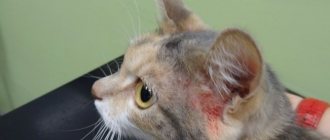One of our readers asked us what it means when a cat keeps scratching its neck. In this case, there is usually an underlying problem that needs to be solved. In this post, we'll look at some of the most common causes of an itchy neck and explain how to solve such problems to give your cat some much-needed relief. First, let's look at the possible answers to this question.
Cats that won't stop scratching their necks usually have parasites, such as fleas or ticks, that need to be addressed. The healing wound may also be itchy and could finally be an allergic reaction to things like house mites or something in your cat's diet.
The cat is constantly itching: type of itching and diagnosis
If, when a breeder visits a veterinary clinic with a complaint that the cat is itching a lot, the specialist immediately prescribes flea treatment without establishing the presence of parasites, you should change the clinic. The rules of the RosVet VC state that the first thing people pay attention to is the type of itching:
- the cat licks and scratches;
- gnaws the body (paws);
- against the background of scratching, he has extensive bald patches (alopecia on the stomach and thighs).
In the future, the doctor follows the standard algorithm for diagnosing pathologies that are accompanied by scratching. A detailed analysis allows us to determine the cause:
- medical history (duration of itching, type of feeding and type of feed, presence/absence of antiparasitic treatment, possibility of allergies);
- analysis of itching (strength, frequency, duration, localization);
- exclusion of fleas, ticks (inspection, scrapings);
- microscopy of scratching sites (scrapings are examined under a microscope).
Externally, the auricle and ear canal are examined for otitis media and marginal seborrhea. They do a feed test (FCA), observe it, and apply an elimination diet. Atopic allergies or obsessive-compulsive disorders (stress, neurosis) are excluded.
It is important to know! There should be a history of previous antipruritic therapy. The breeder explains in detail what they used at home, whether or not they visited another clinic, and what medications were used.
If the cause is identified, the underlying disease is treated. It is not recommended to use drugs against exoparasites “at random”; the symptoms can be smoothed out or distorted and the diagnosis will be made incorrectly.
Main Factors
The causes of acute manifestations of allergies, when a cat scratches its neck until it hurts, can be:
- Food;
- medicines;
- plants, pollen, mold;
- household chemicals;
- cigarette smoke;
- flea saliva (flea medications);
- environmental materials (fabrics, plastic, rubber).
Animals that have the opportunity to walk outdoors are more susceptible to developing reactions to flea bites and plant-derived agents. Even in the absence of obvious presence of insects, damage may occur upon contact with other animals. One flea bite is enough to cause intense itching for several weeks.
Substances and materials in the external environment can provoke severe atopic dermatitis with painful manifestations. The development mechanism most often occurs at the age of up to 3 years. The allergen is very difficult to identify and eliminate.
Various substances and objects from the external environment can be an irritating factor. It is impossible to completely isolate a pet from contact with agents. The pathological condition requires lifelong therapy. Regular use of medications will make your pet’s life easier, making it quite comfortable.
It's possible that when a cat scratches its neck until it bleeds, it may be due to a food allergy. Finding out which food product provokes the reaction is quite difficult. The development of pathology may not occur instantly, but over a long period of accumulation of the immune response to the agent. In the future, with subsequent consumption of the allergenic product, the reaction manifests itself quickly. Quite often it occurs on protein foods.
Why does a cat itch: reasons
There are at least 2 dozen causes of scratching, each has its own specific differences and, in addition to severe itching, is accompanied by a host of symptoms that the breeder must notice. It would be correct if, when collecting an anamnesis, he talks in detail about the nature of the scratch, so the veterinary dermatologist will quickly and accurately diagnose and prescribe treatment.
Sarcoptic mange
Subcutaneous and cutaneous parasites, with them the cat itches, dandruff on the body, crusts:
- otodecosis (itching on the face, ears, back of the head, oily dark deposits in the ears);
- sarcoptic mange (unbearable itching to wounds, localized on the neck, chin, muzzle, body along the ridge, tail root, formation of scabs, hair loss);
- notoedrosis (itching in the area of the brow ridges, the back of the head, on the face, the cat scratches itself until it bleeds, the skin darkens and becomes very thick, folds appear);
- cheyletiellosis (the trigger of itching is a small skin mite located along the ridge and at the root of the tail; the cat is always itching. Visually, through a magnifying glass, you can detect a gray mass of “dandruff” - this is the mite moving, it can move throughout the body).
Cutaneous parasites feeding on the host's blood can be noticed independently or when examining pathological material under a microscope. These are lice, fleas, lice eaters. A distinctive feature is the suddenness of the scratch; the cat literally attacks the bite site, itches and licks. In places of intense scratching, alopecia forms, you can find a cluster of black dots - nits, flea dermatitis is characterized by multiple red dots-rash.
According to observations, up to 90% of cases of itching occur due to flea bites and an allergic reaction in a cat to insect saliva.
Allergy
A cat can develop an allergic skin reaction with itching to anything. More often these are industrial feeds, shampoos, saliva of blood-sucking insects, dust, home fragrances, etc.
If you are allergic to food, the animal scratches its head, groin, or belly. When the allergen is exposed to contact, scratching at the site of the allergen localization. Flea dermatitis is located along the spine, at the root of the tail and on the outer surface of the thighs. If you are allergic to chemicals or perfume, your eyes and nostrils are affected (+ sneezing, drooling).
Bacterial and fungal infection
Fungi and bacteria can become active on the skin, but more often this happens as an addition to the primary infection or a decrease in immunity. The picture of itching will be different, these are weeping and itchy ulcers, eczema. At the same time, the cat constantly licks them, which provokes the formation of large, open wounds, which are then very difficult to stitch.
With dermatophytosis, the cat itches intensely, foci of alopecia and peeling appear, and a dense, reddish border (ringworm) forms around the site of the lesion.
Dermatitis
A collective concept, a general designation for skin lesions. This includes parasitic pathologies, allergies, neurological diseases, etc. It is considered a symptom in a symptom complex and is not considered as an independent disease. There is always: itching, redness, swelling, peeling, swelling of the skin. An increase in local temperature is often associated.
Increased dry skin
Another condition is called dry seborrhea or xerosis. It develops when there is a critical deficiency of vitamins E and A in the feed or due to improper use/selection of shampoos. The epidermis dries out, itches severely, and cracks.
At the beginning, the breeder only notices itching, the cat is worried, scratches its back, sides and ribs, and may gnaw its paws in the joint area. Then dandruff appears, cracks turn into open wounds. Wool loses its shine and elasticity.
Lichen
This disease, which has many varieties, is caused by fungi of the Microsporum, Trichophiton or Epidermophiton species and affects the skin and hair follicles - and not only pets, but also humans. Here are the most common and dangerous types: pityriasis, red flat, pink and ringworm.
The clinical picture in case of lichen infection is as follows: skin lesions with rounded shapes or with uneven edges, accompanied by redness, itching, hair loss and peeling, occurring more often in the head, neck and extremities.
Without properly prescribed treatment, lichen spreads to other parts of the pet's body, and the affected skin can become inflamed and fester, and as a result, sores appear on it - this is due to a bacterial infection.
Only a correct diagnosis will help cure the animal and prevent serious complications.
Internal causes of itching in cats
The most difficult to detect and treat are autoimmune pathologies in which the cat itches. The essence of the problem is a violation of the immune system, when one’s own protective cells begin to perceive the tissues and cells of the epidermis as foreign. They attack them, trying to destroy them.
In the list of pathologies:
- discoid lupus erythematosus. The disease is more common in dogs and is characterized by the sudden appearance of sores on the skin. Conventional antimicrobial therapy does not produce results. The best results are observed with the use of glucocorticoids and immunosuppressants;
- pemphigus foliaceus. The cat scratches its face, especially the bridge of its nose and upper lip. Inflammations, ichor, and crusts appear at this site;
- Jacobs ulcer. This is a “personal” disease of cats, its manifestations are similar to herpes in humans. Spots form on the upper lip, turning into blisters and ulcers. The more advanced the process, the more tissue is affected, up to the exposure of gums and teeth. Wound healing therapy and antibacterial agents are powerless.
The list of neurogenic causes of severe itching in cats includes neurodermatitis and neoplasms (tumors). With neurodermatitis, the pet scratches its head, neck, and ears a lot. Then the pathological process moves to the groin, stomach, back, front legs. In advanced cases, the cat simply chews off its paws due to unbearable itching, and extensive ulcers form throughout the body. Neurodermatitis is transmitted genetically, so animals with this diagnosis are sterilized (neutered).
Tumors, especially malignant ones, can be found throughout the body and attract the cat with mild itching. Scratching only worsens the course of cancer.
Eczema
Eczema affects the top layer of skin, causing redness, a rash, and then oozing blisters. All this causes itching in animals and scratching of inflamed skin. In the event of a bacterial infection, sores appear on areas of the skin affected by eczema - flaky and filled with pus.
In dogs, eczema most often affects the lumbar region, but gradually affects larger areas of the skin. If the process involves deeper layers of skin, then we will talk about dermatitis.
There are many causes of eczema: these are both external and internal factors. Eczema can be caused by diseases of internal organs and endocrine disorders. Therefore, it is so important that a correct diagnosis is made and adequate treatment is prescribed.
After all, no ointments can rid your pet of this insidious disease until you normalize the functioning of its internal organs.
Possible causes of itching
If a cat is constantly itching during examination at the RosVet EC, the following must be excluded/confirmed:
- inflammation of the paraanal glands;
- helminths;
- kidney disease, liver disease and changes in the functioning of the endocrine system;
- otitis;
- marginal seborrhea of the auricles;
- hormonal disorders.
It is important to know! Cats are very susceptible to stress. Behind external equanimity lies a subtle and vulnerable soul, and any psychological discomfort can result in the development of psychogenic itching. OCRD (OCD) is considered an exclusionary diagnosis; behavioral obsessive-compulsive disorder is expressed in the constant habit of scratching and biting oneself. This is a psychological dependence on the process itself, from boredom, the paws and tail suffer (it gets chewed off).
Features of the reaction
Signs of different types of allergies have similar manifestations. A pathological reaction to flea saliva can cause extensive damage to the croup, back and tail. Food allergies most often occur in the head and neck area. Periods of seasonal exacerbation are also possible. The phenomenon is most typical for atopic dermatitis.
It is important to find out in a timely manner why your cat scratches its neck a lot. Ulcers, open wounds and rashes can pose a serious threat to the health and life of a pet, acting as a source of secondary infection. Some members of the cat family are more prone to allergic reactions.
This fact is explained by heredity and the characteristics of the breed. Pronounced signs can manifest themselves against the background of insufficiency of the enzymatic system, congenital pathologies of the gastrointestinal tract, and unfavorable ecology of the habitat.
Owner actions: diagnosis and treatment
Without fail, as soon as the breeder notices that the domestic cat is itching, the animal must be taken for examination to the RosVet VC to a veterinary dermatologist. In the clinic:
- check the ears and face;
- microscopy of scrapings and trichoscopy will be performed;
- carry out bacterial and fungal cultures;
- They will do histology and cytology of the problem area.
Without fail, if there is a suspicion of an allergy from food, an “elimination diet” is prescribed. This means that “old” ingredients will be gradually removed from the diet and replaced with new ones. As soon as the allergy passes, the allergen is found. But this is a very long process, sometimes lasting months.
Species-specific allergy tests are rarely carried out in cats due to their high cost and low information content.
Treatment for itching in cats
It is impossible to treat a cat with anti-flea agents, use antibacterial ointments or any medications without a veterinarian’s prescription. It is important to first make an accurate diagnosis, then use medications. Otherwise, the true clinical picture will be blurred, the disease will progress and the general condition of the pet will worsen.
Treatment happens:
- etiotropic (that is, they act directly on the provoking factor of itching, the cause);
- symptomatic (eliminate directly).
The list of prescriptions may include antihistamines, atopic, glucocorticosteroids, pentoxifylline, Omega-3, and psychotropic drugs.
If your cat is itching, do not rush to treat it for fleas. The causes of itching are numerous and incorrect use of remedies will not help the animal, but will only increase its suffering. Call the RosVet VC by phone, 24 hours a day. Make an appointment for your cat to see a veterinary dermatologist.
Prices for appointments in our clinics
| Name of veterinary services | Unit | Price, rub |
| ⭐ Initial appointment | 1 animal | 400 |
| ⭐ Repeated appointment | 1 animal | 250 |
| Initial appointment with a specialist | 1 animal | 1100 |
| Consultation without an animal | — | 550 |
| Consultation with a doctor based on test results | 1 PC. | 400 |
| Weighing animals | 1 animal | For free |
| Additional fixation for aggressive animal behavior | 1 animal | 700 |











